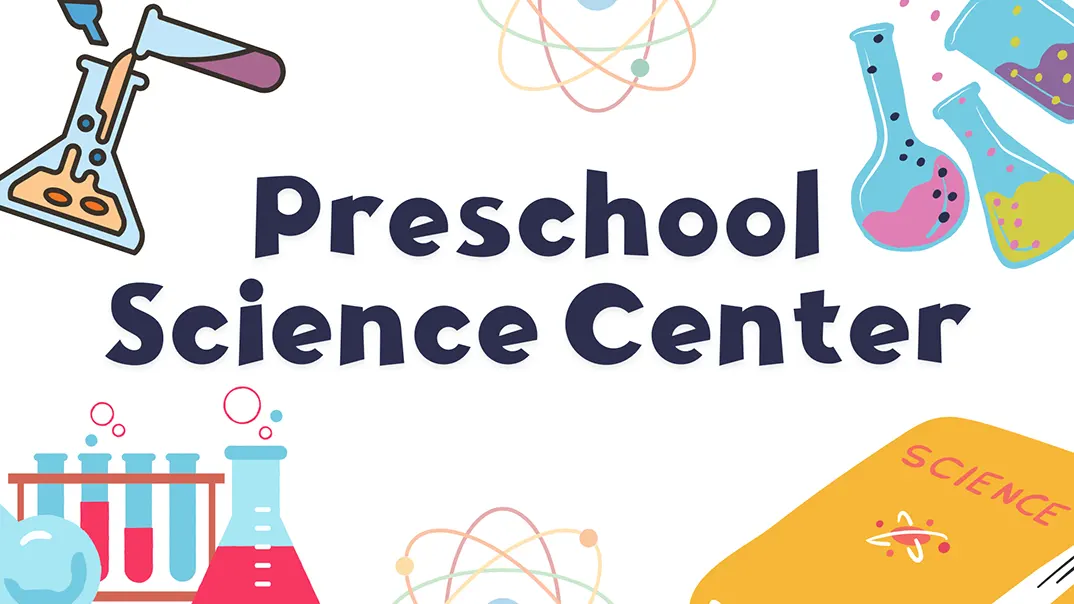Science learning begins long before formal schooling. According to the National Science Teachers Association (NSTA), young children “have the capacity for conceptual learning and the ability to use the skills of reasoning and inquiry” as they investigate how the world works. Early experiences in science‑rich environments can strengthen children’s critical thinking and set the stage for later academic success.
Despite this, many preschool classrooms offer limited opportunities for consistent scientific exploration. Educators may lack guidance on how to set up science center or what materials are most appropriate for young learners. Research in early childhood science education highlights this gap and calls for intentional design of learning environments to support inquiry.
A well‑designed preschool science center provides a dedicated space where curiosity is encouraged and investigation becomes part of the daily learning experience. This article offers practical strategies for setting up a preschool science center that supports early inquiry.
Why Is the Science Center Important in Preschool?
The preschool years are a critical time for developing foundational skills in thinking, problem-solving, and communication. A well-planned preschool science center supports all of these areas by providing children with opportunities to explore, ask questions, and discover how the world works through hands-on experiences.
1. Encourages Natural Curiosity and Inquiry
Young children are naturally eager to explore the world around them. A well-prepared Science Center allows them to observe, ask questions, and test ideas safely. Through experiments and predictions, they learn to find answers by investigating. This type of exploration strengthens confidence and helps them think more deeply about what they see.
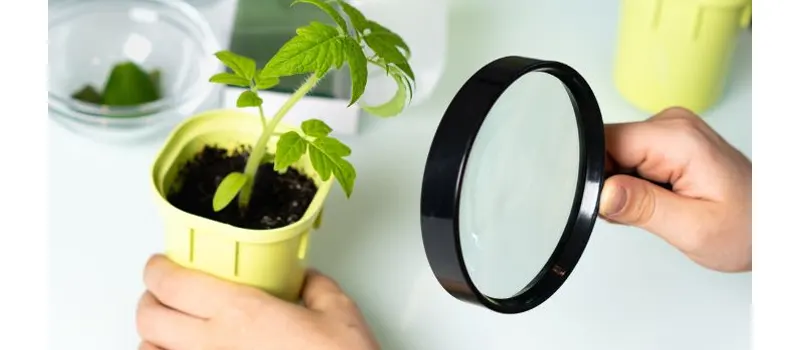
2. Builds Foundational STEM Skills
The preschool science center introduces children to the basic ideas of science, technology, engineering, and mathematics. When they measure, compare, and explore materials, they begin to understand cause and effect, quantity, and spatial relationships.
- Science: Observing nature, exploring how things move, and discovering changes in materials.
- Technology: Using simple tools such as magnifiers, droppers, or scales to support accurate observation.
- Engineering: Building bridges, ramps, or towers to explore structure, stability, and motion.
- Mathematics: Measuring, sorting, counting, and recognizing patterns during investigation.
3. Enhances Language and Communication
Science activities give children many opportunities to talk, ask questions, and describe what they see. As they share discoveries with teachers and classmates, their vocabulary and communication skills grow. Teachers can model clear and descriptive language, using terms such as observe, compare, predict, and result. This process strengthens both scientific understanding and early literacy.
4. Promotes Fine and Gross Motor Development
Exploration in the science center involves actions such as pouring, mixing, and sorting, which develop coordination and control. Using tweezers, droppers, or small tools refines hand movements, while lifting, arranging, or building with larger materials develops balance and overall strength. These activities help children improve precision, focus, and body awareness.
5. Encourages Collaboration and Social Learning
Children often work together in the science center, sharing materials and discussing their ideas. This experience helps them practice cooperation, patience, and listening. They learn how to respect others’ opinions and solve problems as a group. Collaborative exploration turns the Science Center into a place where teamwork and discovery happen at the same time.
6. Supports Cognitive and Critical Thinking Skills
Every experiment invites children to observe carefully, test their ideas, and reflect on what happens. This process improves attention, memory, and reasoning. As children compare results or change their approach, they develop logical thinking and problem-solving skills that are essential for all areas of learning.

7. Connects Classroom Learning with the Real World
The Science Center helps children see how classroom learning connects with everyday life. When they grow plants, study weather, or explore magnets, they understand that science is part of the world around them. These experiences make learning meaningful and help children develop curiosity about their environment.
8. Fosters Confidence and Independence
When children experiment, make discoveries, and record what they find, they feel proud of their efforts. The Science Center allows them to make choices, take small risks, and learn from both success and mistakes. This sense of ownership builds confidence and independence, which encourages a lifelong interest in learning.
How to Set up the Preschool Science Center?
What does science look like to a four-year-old? It might be a leaf floating in water, the squish of mud between fingers, or a flashlight casting shadows on the wall. When you set up a preschool science center, you’re creating a lens for children to observe and make sense of the world. It’s less about equipment and more about setting the stage for “Aha!” moments.
1. Choose the Right Location
Select a quiet yet visible area of the classroom where children can focus on exploration without distraction. The space should have:
- Natural light to observe shadows, plants, or weather changes.
- Nearby access to water for experiments involving liquids.
- Flat, stable surfaces for placing trays, tools, and materials.
- Good visibility so teachers can supervise safely.

2. Plan the Layout According to Classroom Size
The way you plan the Science Center should depend on the size of your classroom. A thoughtful layout ensures that every child has enough space to explore safely while maintaining a sense of order and focus. The goal is to balance accessibility, organization, and flexibility.
Small Classrooms:
For small classrooms, the main focus is on flexibility and efficient use of space. Every piece of furniture and every tool should serve multiple purposes. Teachers need to prioritize mobility and storage to prevent overcrowding.
- Use a small table, rolling cart, or narrow shelf that can be moved or folded when needed.
- Select lightweight materials such as magnifiers, jars, and trays that can be stored easily.
- Rotate themes frequently to maintain interest without filling the area with too many objects.
- Display posters or observation charts on walls to extend learning vertically rather than horizontally.
Medium-sized Classrooms:
In medium-sized classrooms, the goal is to create a clear and consistent science area without taking space away from other learning centers. The Science Center can become a semi-permanent part of the room that supports group exploration. Teachers should focus on organization and accessibility so that children can explore safely and independently.
- Dedicate one full corner or wall section for science activities.
- Create two zones, such as an observation table and a nature display shelf.
- Use mobile carts or rolling storage units to make setup flexible.
- Provide enough space for two to four children to explore comfortably at the same time.
Large Classrooms:
For large classrooms, the Science Center can be a central feature of the learning environment. Here, the focus is on variety, collaboration, and long-term exploration. Teachers can plan multiple zones that allow children to explore different scientific concepts at the same time.
- Designate a full area with multiple zones, such as an experiment station, nature zone, and recording area.
- Offer real plants, water trays, and measuring tools to encourage authentic observation.
- Provide clear walking paths between zones to maintain safety and order.
- Encourage small group collaboration and extended investigations.
3. Select Age-Appropriate and Safe Materials
Choose materials that are simple, durable, and developmentally suitable. The goal is to provide open-ended resources that allow children to explore freely. All materials should be non-toxic and regularly checked for damage. Avoid objects with sharp edges or small parts that may pose safety risks.
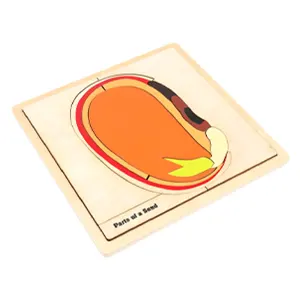
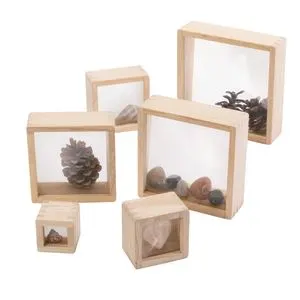

Ready to design a space that inspires learning? Connect with us to create customized furniture solutions tailored to your classroom needs.
4. Organize for Independence and Routine
Arrange all materials at child level to support independent exploration. Use labeled bins or trays with both pictures and words to make cleanup easy. Establish simple routines for using and returning items. This organization helps children build responsibility, patience, and pride in maintaining the classroom environment.
5. Add Visual and Learning Supports
Provide visual prompts that guide children’s thinking. Use posters, photo charts, and simple vocabulary cards to introduce new ideas. Include drawing pads, clipboards, or data sheets for children to record their findings. Prompts like “What did you notice?” or “What changed after you mixed them?” encourage reflection and conversation.
6. Rotate Themes and Materials Seasonally
To keep the Science Center fresh and exciting, rotate materials based on seasons or classroom topics. Rotating materials keeps children engaged and connects classroom science to the natural world outside.
- Spring: Explore seeds, plants, and growth.
- Summer: Study shadows, light, and water.
- Autumn: Investigate leaves, textures, and color changes.
- Winter: Observe ice, snow, and temperature.
7. Maintain Safety and Cleanliness
Safety should guide every decision in the Science Center. Teach children how to handle materials gently, clean up spills, and wash hands before and after experiments. Store liquids securely and replace worn or damaged items promptly. A clean and well-maintained space helps children focus on learning without distraction.
8. Integrate Science into Daily Routines
Encourage children to visit the Science Center during free play, small group time, or transitions. Let them record weather, measure growth, or check classroom plants as part of their daily routine. When science becomes a regular part of classroom life, curiosity and exploration grow naturally.
Theme Ideas for Preschool Science Center
Creating a Preschool Science Center with defined themes helps children connect their discoveries to real-world experiences. Each theme brings a unique way of exploring the natural world and provides opportunities to rotate materials throughout the year.
1. Nature Exploration
Children explore the beauty of the natural world by collecting and studying seeds, rocks, leaves, and shells. This theme helps them observe similarities and differences, classify natural objects, and develop an appreciation for living and nonliving things. It strengthens observation skills and encourages respectful curiosity toward the environment. Through repeated exploration, children build vocabulary and basic scientific reasoning.

Layout Suggestions:
- Choose a well-lit area near a window to use natural light for observation.
- Set up a low wooden table or display shelf for collections of natural items.
- Add small containers or trays for sorting materials by color, shape, or texture.
- Include a wall display for photos or labels of natural objects.
Recommended Furniture and Materials:
- Observation table or display shelf
- Magnifying glasses and transparent jars
- Sorting trays, baskets, and clipboards
- Potted plants, seed samples, and labeled cards
- Sketch pads, pencils, and nature picture books
Ready to design a space that inspires learning? Connect with us to create customized furniture solutions tailored to your classroom needs.
2. Weather and Seasons
This theme helps children understand the patterns and changes in daily weather. Through direct observation, they learn about sunlight, wind, rain, and temperature. Children begin to recognize how weather affects clothing choices, outdoor play, and the natural world. Recording and comparing daily conditions also develops math and reasoning skills while encouraging consistent observation.
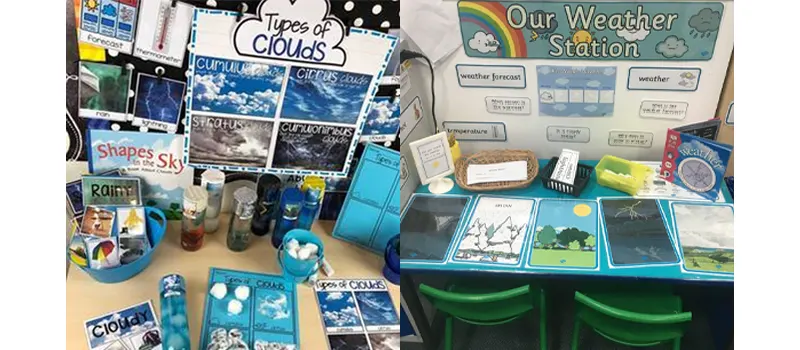
Layout Suggestions:
- Select a space near a window or door where children can easily view the sky and outdoor environment.
- Mount a weather chart or whiteboard for daily updates with movable icons or cards.
- Place a small table for tools such as thermometers, rain gauges, and wind socks.
- Provide open floor space so children can safely use measuring tools or track rainfall samples.
- Add a wall pocket or shelf to store notebooks, pencils, and recording sheets.
Recommended Furniture and Materials:
- Weather chart or observation board
- Thermometers, rain gauges, and barometers
- Transparent measuring cups for collecting water samples
- Clipboards, notebooks, and picture cards for weather symbols
- Light table or mirror set for sunlight exploration
3. Life Circle Science and Growth
This theme introduces children to the concept of growth, change, and renewal in living things. By observing plants sprouting, insects transforming, or frogs developing, children gain a clear understanding of life stages and biological processes. They learn patience and responsibility through daily care and observation while developing empathy for living organisms. The focus is on connecting real experiences with scientific observation and gentle interaction.
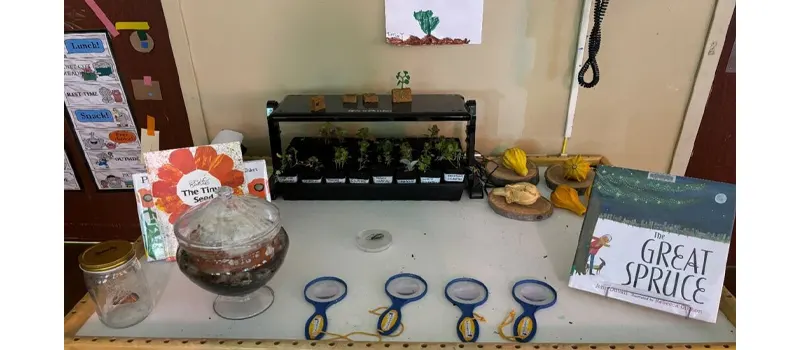
Layout Suggestions:
- Choose a sunny, ventilated area with access to natural light for growing plants or keeping small habitats.
- Set up a low table or shelf with clear containers for seedlings, caterpillars, or tadpoles.
- Include labeled trays for tools such as droppers, watering cans, and feeding utensils.
- Display a growth chart or photo board showing different stages of development.
- Keep a cleanup area nearby with paper towels and a small waste bin to maintain hygiene.
Recommended Furniture and Materials:
- Planting shelf or science display table
- Terrariums, seed trays, and insect observation jars
- Magnifiers, droppers, and spray bottles
- Growth charts, notebooks, and pencils
- Reference cards or picture books on plant and animal life cycles
4. Physical Science
This theme introduces children to the basic principles of physical science through hands-on exploration. By experimenting with magnets, ramps, and simple machines, children discover how objects move, roll, push, pull, attract, or repel. These activities promote curiosity, problem-solving, and early engineering thinking. As they test their ideas, children learn to make predictions, observe outcomes, and explain their reasoning in simple terms.

Layout Suggestions:
- Select a flat, open area with durable flooring for safe movement and experimentation.
- Provide a low table or ramp platform for testing rolling and sliding objects.
- Set up separate bins for magnets, wheels, and movable parts to keep materials organized.
- Add a wall or board for displaying diagrams, photos, and results of their experiments.
Recommended Furniture and Materials:
- Science activity table or ramp platform
- Magnet wands, magnetic blocks, and sorting trays
- Wooden blocks, toy cars, and balance scales
- Simple pulleys, levers, and small wheels
- Clipboards, pencils, and recording charts for results
5. Light and Shadow
Children explore how light travels, reflects, and makes shadows. They compare transparent, translucent, and opaque objects and describe what they see. Simple experiments lead to predictions about where shadows will appear and how they change. The center encourages careful language and visual reasoning through direct observation.
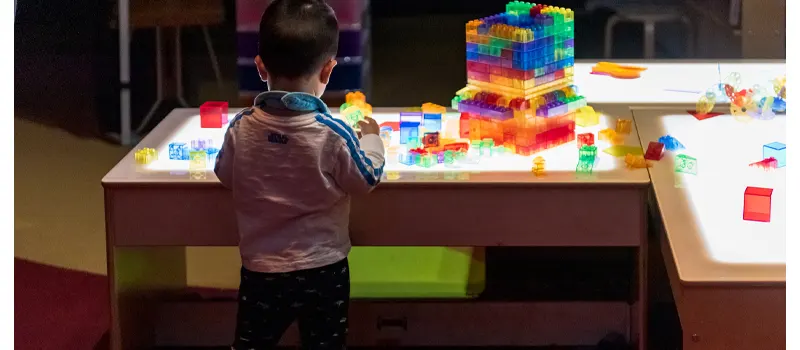
Layout Suggestions:
- Choose a semi-darkened area or add curtains to control lighting.
- Place a light table or adjustable lamp on a sturdy surface.
- Keep mirrors, prisms, and transparent materials within easy reach.
- Leave a clear wall or panel space for tracing shadows.
- Provide a basket for organizing color filters and flashlights.
Recommended Furniture and Materials:
- Light table or portable lamp
- Transparent and opaque blocks
- Mirrors, prisms, and colored films
- Drawing paper and pencils
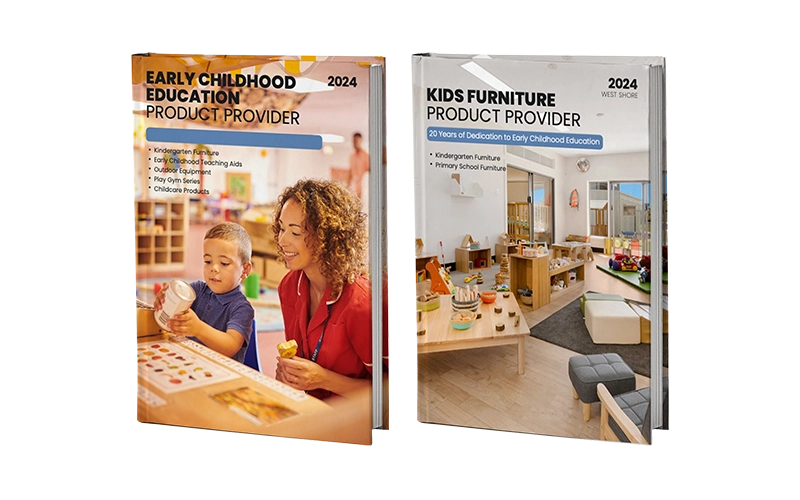
Science Activities for Preschoolers
The Preschool Science Center becomes more meaningful when paired with short, hands-on activities that spark curiosity. Activities should be simple, safe, and easy to rotate throughout the year. Each one allows children to test ideas, observe changes, and discuss their findings. Teachers can integrate these mini experiments into daily routines or thematic learning plans to keep exploration active and exciting.
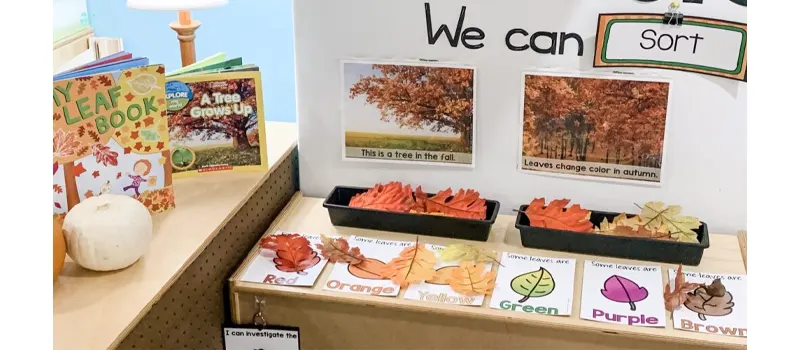
- Color Mixing: Provide clear cups of water and food coloring. Let children combine colors and record what new shades appear.
- Floating and Sinking: Offer a basin of water with different objects. Ask children to predict and test which items float or sink.
- Magnet Hunt: Give each child a magnet wand and invite them to explore which classroom objects attract magnets.
- Plant Growth Observation: Place beans or seeds in transparent cups with cotton and water, then track growth daily.
- Shadow Tracing: On sunny days, let children trace each other’s shadows and compare shapes at different times.
- Ice Melting Experiment: Provide ice cubes and salt to see how temperature and materials change melting speed.
- Weather Watch: Use thermometers or wind socks outdoors and help children record temperature and wind direction.
Each activity can be adjusted for different age groups and classroom sizes. To explore more creative and detailed experiments, visit the full article “ 30 Fun and Easy Science Activities for Preschoolers That Ignite Curiosity”
Conclusion
Designing a Science Center requires careful attention to both structure and flexibility. A clear layout, safe materials, and accessible tools allow children to explore independently while staying organized. When teachers plan the environment with intention, the Science Center becomes a place of discovery that integrates smoothly into daily routines.
At Westshore, we help educators bring these ideas to life by providing complete one-stop solutions for Science Center design. Our services include classroom layout planning, customized preschool furniture, and full setup support. Whether you are creating a new space or improving an existing one, Westshore can help you achieve a safe, functional, and inspiring Preschool Science Center that fits your educational vision.

